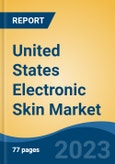Speak directly to the analyst to clarify any post sales queries you may have.
10% Free customizationThis report comes with 10% free customization, enabling you to add data that meets your specific business needs.
Its application spans diverse fields such as robotics, prosthetics, and wearable devices. In robotics, e-skin grants machines a tactile interface with the environment; in healthcare, it enhances prosthetic feedback and improves user experience in wearables. As the integration of technology into daily life becomes increasingly seamless, e-skin opens new avenues in human-machine interaction and health monitoring. Continued innovation in this field is anticipated to drive advancements in personalized healthcare, assistive technology, and smart interfaces across industries.
Key Market Drivers
Growth in Wearable Technology Sector
The accelerating expansion of the wearable technology sector is a major driver of growth in the United States Electronic Skin Market. As demand rises for sophisticated health monitoring tools and activity trackers, electronic skin - capable of mimicking the sensory functions of human skin - is gaining prominence in next-generation wearables. These flexible, stretchable sensors provide continuous, real-time data capture, aligning with the increasing consumer focus on fitness, wellness, and preventive healthcare.With more individuals turning to wearables for daily health insights, e-skin technology offers a compelling solution that enhances device comfort, accuracy, and responsiveness. Additionally, substantial investments from major technology firms in research and development are fueling innovation, enabling more advanced and user-friendly wearable devices. These advancements not only meet consumer expectations but also create new use cases for electronic skin in clinical and non-clinical environments, further strengthening its market appeal.
Key Market Challenges
Stringent Government Regulations
The growth of the United States Electronic Skin Market is challenged by strict regulatory frameworks, especially where e-skin devices intersect with medical and healthcare applications. The classification of certain e-skin technologies as medical devices by regulatory authorities such as the FDA triggers stringent approval processes, including extensive safety and efficacy testing.These regulatory requirements entail significant costs and delays, which can deter new entrants and slow time-to-market for innovative products. Additionally, concerns surrounding user data privacy and cybersecurity - especially when personal health information is transmitted via connected e-skin devices - are prompting calls for further legislative oversight. These factors contribute to increased compliance complexity and product development costs, ultimately affecting consumer accessibility and limiting broader market adoption, particularly for startups or smaller manufacturers.
Key Market Trends
Advancements in IoT and AI Technologies
Technological advancements in the Internet of Things (IoT) and Artificial Intelligence (AI) are significantly influencing the development and adoption of electronic skin in the United States. E-skin technologies embedded with IoT capabilities allow for seamless communication with external devices and networks, enabling real-time monitoring and data transmission in applications such as remote patient care and robotic control.When integrated with AI, electronic skin systems can interpret complex datasets, adapt to user behaviors, and deliver predictive insights - enhancing the utility of wearable medical devices and interactive machines. In healthcare, this integration supports early detection of anomalies and personalized treatment strategies, while in robotics, it facilitates more nuanced environmental responses. As AI and IoT continue to converge with wearable technologies, the demand for smart, sensor-rich electronic skin is expected to grow across healthcare, consumer electronics, and industrial robotics sectors.
Key Market Players
- Philips Healthcare USA
- Insulet Corporation
- Dexcom, Inc.
- Abbott Laboratories, Inc.
- 3M Company
- VivaLnk, Inc.
- MC10, Inc.
- Xenoma, Inc.
- GENTAG, Inc.
- iRhythm Technologies, Inc.
Report Scope:
In this report, the United States Electronic Skin Market has been segmented into the following categories, in addition to the industry trends which have also been detailed below:United States Electronic Skin Market, By Product:
- Electronic Skin Patches
- Electronic Skin Suit
United States Electronic Skin Market, By Component:
- Stretchable Circuits
- Photovoltaics System
- Stretchable Conductors
- Electro-Active Polymers
United States Electronic Skin Market, By Sensor Type:
- Tactile Sensors
- Chemical Sensors
- Electrophysiological Sensors
United States Electronic Skin Market, By Application:
- Health Monitoring Systems
- Drug Delivery Systems
- Cosmetics
United States Electronic Skin Market, By Distribution Channel:
- Hospitals & Clinics
- Cosmetic Companies
- Others
United States Electronic Skin Market, By Region:
- Northeast Region
- Midwest Region
- West Region
- South Region
Competitive Landscape
Company Profiles: Detailed analysis of the major companies present in the United States Electronic Skin Market.Available Customizations:
With the given market data, the publisher offers customizations according to a company's specific needs. The following customization options are available for the report.Company Information
- Detailed analysis and profiling of additional market players (up to five).
This product will be delivered within 1-3 business days.
Table of Contents
Companies Mentioned
- Philips Healthcare USA
- Insulet Corporation
- Dexcom, Inc.
- Abbott Laboratories, Inc.
- 3M Company
- VivaLnk, Inc.
- MC10, Inc.
- Xenoma, Inc.
- GENTAG, Inc.
- iRhythm Technologies, Inc.
Table Information
| Report Attribute | Details |
|---|---|
| No. of Pages | 85 |
| Published | June 2025 |
| Forecast Period | 2024 - 2030 |
| Estimated Market Value ( USD | $ 1.42 Billion |
| Forecasted Market Value ( USD | $ 2.3 Billion |
| Compound Annual Growth Rate | 8.3% |
| Regions Covered | United States |
| No. of Companies Mentioned | 10 |









